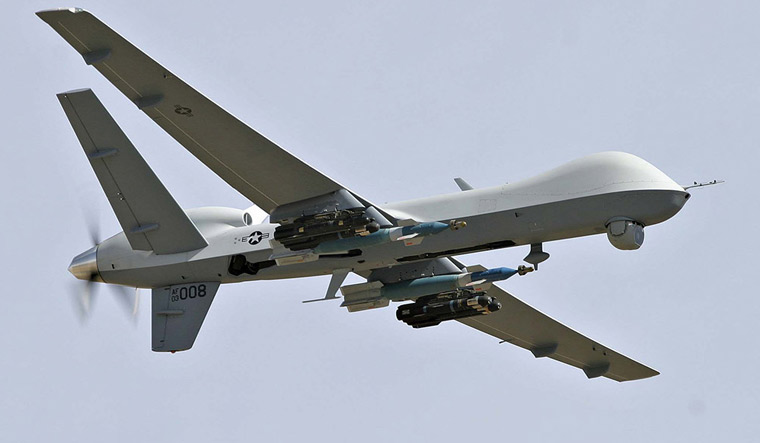Talk of a large order of unmanned aerial vehicles from the US for the three Indian armed services has been in the news from early in the Donald Trump era. Last December, Indian Navy chief Admiral Karambir Singh revealed the Navy had leased two MQ-9B SeaGuardian drones from US company General Atomics for surveillance in the Indian Ocean. He also announced that purchase of additional drones was high on the government's agenda.
On Tuesday, Bloomberg reported India will approve in April the purchase of up to 30 drones from General Atomics at a cost of $3 billion. Bloomberg reported the drones "will give the Indian Navy the ability to better monitor Chinese warships in the southern Indian Ocean, and equip the army to engage targets along the disputed India-Pakistan border in the Himalayas".
Predator or Reaper?
General Atomics built the Predator drones that became legendary for their use as a weapon of choice for carrying out assassinations of terrorists using air-to-surface missiles. The original Predator was designated the MQ-1 and had a maximum takeoff weight of about 1 tonne. The US Air Force retired the MQ-1 Predator in 2018 and transitioned to a new system from General Atomics: The MQ-9A Reaper. The MQ-9A Reaper first flew in February 2001.
Confusingly, the MQ-9A Reaper has been referred to as the Predator-B. The Reaper was derived from and resembles the original MQ-1 Predator, which was used in the US conflicts in Afghanistan and Iraq. However, the Reaper is a totally different system.
Courtesy of a more powerful engine, the MQ-9A Reaper has a maximum takeoff weight of about 4.7 tonnes, over four times that of the MQ-1 Predator. In addition, while the original Predator could carry only two Hellfire anti-tank missiles, the Reaper has an external payload limit of over 1 tonne, giving it a massive firepower boost. This gives it the capability to carry up to four Hellfire missiles and two 227kg bombs on the same mission. Both the Predator and Reaper are controlled by personnel on the ground using satellite datalinks. General Atomics claims the MQ-9A Reaper can remain airborne for over 27 hours.
The MQ-9B SeaGuardian is a variant of the Reaper optimised for maritime missions. According to General Atomics, the MQ-9B SeaGuardian can carry out roles such as anti-submarine warfare and maritime surveillance. The company has also talked of developing it for use a platform to detect naval mines. The MQ-9B is equipped with a powerful radar to scan the ocean surface and can carry sonobuoys to detect submarines. According to General Atomics, the MQ-9B SeaGuardian has a maximum takeoff weight of over 5.6 tonnes and can remain airborne for over 40 hours.
The Reaper and Predator can remain airborne for several hours at a time, relying back data to operators and planners. The Reaper can also use its missiles to hit 'targets of opportunities' such as terrorists on the move or missile systems.
The Bloomberg report said India would be buying the ‘MQ-9B Predator’; however, it is likely both the Reaper and SeaGuardian will be purchased given differing service requirements. Interestingly, in 2019, Breaking Defense, a US publication, reported India and the US were in talks to customise the Reaper for Indian military requirements. This included modifying the weapon systems and communications equipment.
If confirmed, the deal for 30 drones will make India one of the largest operators of the MQ-9A Reaper family. The expected deal with the US comes as Pakistan is expecting delivery of Chinese-built drones that can carry missiles.





